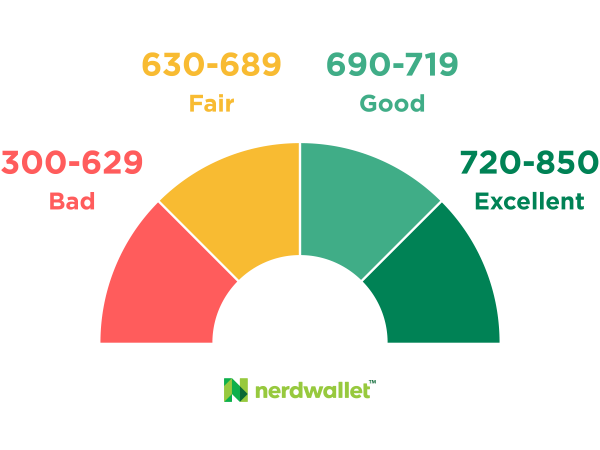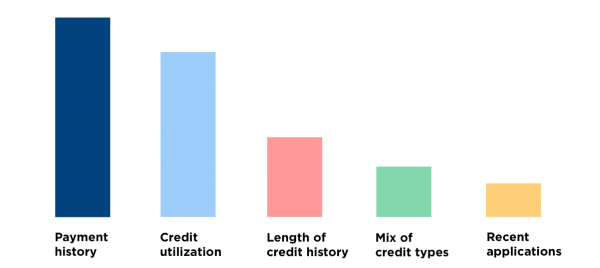Credit Score Ranges: What They Mean and How They Work
Credit scores estimate your likelihood of repaying new debt. Learn what range your score falls in and how to grow it.

Many, or all, of the products featured on this page are from our advertising partners who compensate us when you take certain actions on our website or click to take an action on their website. However, this does not influence our evaluations. Our opinions are our own. Here is a list of our partners and here's how we make money.
Credit scores are three-digit numbers from 300 to 850 that are calculated using information from your credit reports.
Those scores fall into credit score ranges that generally determine whether your score is excellent (720-850), good (690-719), fair (630-689) or poor (300-629). Typically, people with scores in the good or excellent range have more access to better financial products.
The two most prominent credit scores are from FICO and VantageScore. They have their own distinct credit scoring ranges and weight the credit scoring factors differently.
The factors that make the biggest impact on your score, and whether you move up or down in the credit ranges, are paying on time and credit utilization, or the amount of available credit you're using.
Credit scores influence many aspects of your life: whether you get a loan or credit card, what interest rate you pay, or whether you get the apartment you want. They're grouped into credit score ranges — generally defined as excellent, good, fair and poor — and lenders use these ranges when assessing potential applications for mortgages, credit cards, auto loans and other purchases like a cell phone.
A higher credit score can give you access to more financial products — and at lower interest rates. Borrowers with scores above 750 frequently have many options, including the ability to qualify for 0% financing on cars and for credit cards with 0% introductory interest rates.
There's a lot at stake, so it pays to know what your credit score is and what credit score range it falls in.
What is a credit score?
A credit score is a three-digit number, usually on a scale of 300 to 850, that estimates how likely you are to repay borrowed money and pay bills.
Credit scores are calculated from information about your credit accounts. That data is gathered by credit-reporting agencies, also called credit bureaus, and compiled into your credit reports. The three largest bureaus are Equifax, Experian and TransUnion.
You don't have a single credit score — you have a few, and they probably vary slightly. That's because two major companies calculate scores and weight certain credit behaviors differently (more on that below).
The highest credit score you can get is 850, although there's not much difference between a "perfect" score and an excellent score when it comes to the rates and products you can qualify for. In other words: Don't stress over trying to achieve an 850 score, especially because scores tend to fluctuate frequently.
What are the credit score ranges?
The two companies that dominate credit scoring, FICO and VantageScore, use models that vary. But both use a credit score range of 300 to 850. These are the general guidelines:

A score of 720 or higher is generally considered excellent credit.
A score of 690 to 719 is considered good credit.
Scores of 630 to 689 are fair credit.
And scores of 629 or below are bad credit.
In addition to your credit score, factors like your income and other debts may play a role in creditors' decisions about whether to approve your application.
What factors impact your credit scores?
FICO and VantageScore consider many of the same factors but weight them somewhat differently when calculating your score.
For both scoring models, the two things that matter most are:
Payment history. A misstep in making on time payments can be costly. A late payment that's 30 days or more past the due date stays on your credit history for years.
Credit utilization. This term describes how much of your credit limits you are using. It's good to use less than 30% of your credit limits — lower is better. You can take several steps to lower your credit utilization.
Much less weight goes to these factors, but they're still worth watching:
Credit mix: Scores reward having more than one type of credit — a traditional loan and a credit card, for example.
How recently you have applied for credit: When you apply for credit, a hard inquiry on your credit report may result in a temporary dip in your score.

Factors that don’t affect your credit scores
There are some things that are not included in credit score calculations, and these mostly have to do with demographic characteristics.
For example, your race or ethnicity, sex, marital status or age aren’t part of the calculation. Neither is your employment history — which can include things like your salary, title or employer — nor where you live.
How to improve your credit
Your credit score is an attempt to predict your financial behaviors. If you’re unhappy with the range where your credit score currently falls, you can start implementing some things to take it to the next level. The factors that go into your score point out reliable ways you can build up your score:
Pay all bills on time.
Keep credit card balances under 30% of their limits, and ideally much lower.
Keep older credit cards open to protect the average age of your accounts, and consider having a mix of credit cards and installment loans.
Space out credit applications over time rather than submitting many in a short period. Typically, lenders will initiate a "hard pull" on your credit when you apply, which temporarily dings your score. Too many applications too close together can cause more serious damage.
There are several ways to build credit when you're just starting out and ways to bump up your score once it's established. Doing things like making payments to your credit card balances a few times throughout the month, disputing errors on your credit reports, or asking for higher credit limits can elevate your score.
» MORE: How to improve your credit
How can I check and monitor my credit?
You can check your own credit — it's free and doesn't hurt your score — and know what the lender is likely to see.
You can get a free credit score from a personal finance website such as NerdWallet, which offers a VantageScore 3.0 using data from your TransUnion credit report. Many personal banking apps also offer free credit scores, so you can make a habit of checking in when you log in to pay bills.
Remember that scores fluctuate. As long as you keep it in a healthy range, those variations won’t have an impact on your financial well-being. Bigger jumps might be cause for concern, indicating a missed payment or something more insidious, like identity theft.
You can help protect your credit by freezing your credit with each credit bureau. You can still use credit cards, but no one can apply for credit using your personal data because access is blocked when your credit is frozen. Freezing your credit takes only a few minutes, but it goes a long way in protecting your finances.


